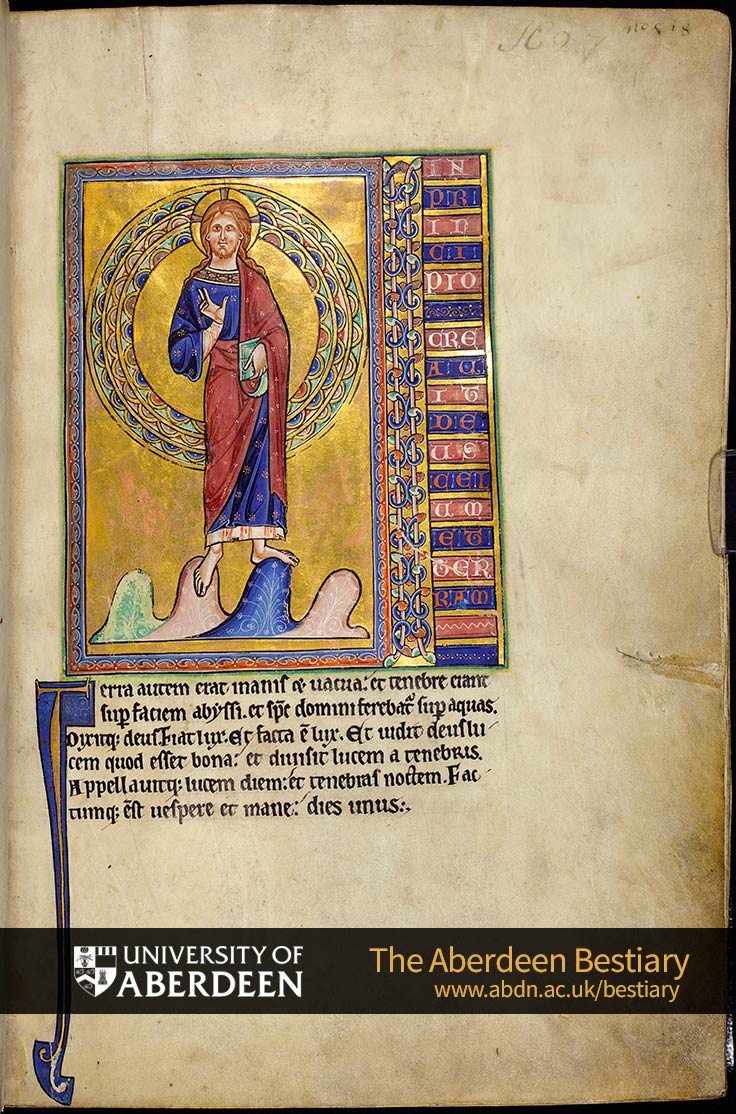- Commentary
-
Commentary
Text
Genesis 1:1-5.
Illustration
the Creation of Heaven and Earth. The first sentence of the book is incorporated into the illustration with the wording on alternating blue and pink ground. To the left of this is a column of interweaving foliage ornament. The main picture shows God standing frontally with his right hand blessing and his left hand clasping a book. He wears a blue robe and red cloak and has a small ginger beard. The three circles which surround him fit within the frame and are decorated with coloured semicircles. He stands on four floating rocks of different colour covered with a white filigree ornament. The background is pure burnished gold. The restrained use of colour, predominantly blue, pinky-red and gold with a little green is sumptuous. This scene is closely modelled on the illustrated Hexaemeron by St Ambrose (Munich, Staatsbib. MS clm. 14399, ff. 14v, 21v) made at St Emmeram, Regensburg, c.1125-50. Earlier Creation scenes based on cosmic circles are in the Michelbueren Bible (Stiftsbib. cod. perg. 1, f.6. Both illus. Muratova 1984a, VII, VIII). On these continental examples the inner cosmic circles are decorated with billowing, cloud-like semicircles. In this respect Aberdeen f.1r and f.1v are closer to the continental models than the Ashmole Bestiary (f.4v) where a zig-zag pattern has appeared. The four rocks at the base may represent the four elements, earth, air, fire and water (Zahlten 1979, 12). In that case the Ashmole artist has misunderstood the model by using only three rocks. This page still bears the sixteenth-century inventory number, 518, from the Old Royal Library, Westminster, and H.2.7 in eighteenth-century hand, a shelf mark from Marischal College. For further information refer to the essay The Aberdeen Bestiary: the history of the manuscript. Initial type 3.
- Transcription and Translation
-
Transcription
In\ pr\in\ci\pio\ cre\av\it\ de\us\ cel\um\ et ter\ram.\ Terra autem erat inanis et vacua, et tenebre erant\ super faciem abyssi, et spiritus domini ferebatur super aquas.\ Dixitque deus: Fiat lux. Et facta est lux. Et vidit deus luc\em quod esset bona, et divisit lucem a tenebris.\ Appellavitque lucem diem, et tenebras noctem. Fac\tumque [e]st vespere et mane, dies unus.\Translation
'In the beginning God created the heaven and the earth. And the earth was without form, and void; and darkness was upon the face of the deep. And the Spirit of God moved upon the face of the waters. And God said, Let there be light: and there was light. And God saw the light, that it was good; and God divided the light from the darkness. And God called the light Day and the darkness he called Night. And the evening and the morning were the first day' (Genesis, 1: 1-5).

